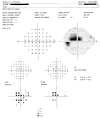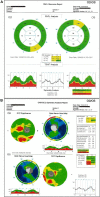The Hub-and-Spoke Management of Glaucoma
- PMID: 32256306
- PMCID: PMC7090234
- DOI: 10.3389/fnins.2020.00180
The Hub-and-Spoke Management of Glaucoma
Abstract
Glaucoma is an extremely significant public health issue, since it is the most common cause of irreversible blindness worldwide, nevertheless it is still widely undiagnosed because of its devious nature. Glaucoma diagnosis criteria are well-defined and have to be strictly observed and recognized: the earlier the disease is diagnosed, the earlier the patient can undergo the most suitable treatment, the better can be the prognosis. The three levels of prevention are essential in the approach to the disease and its pathophysiological features make it eligible for screening. This review provides an overview of the current state of the art in glaucoma management, starting from its prevention and coming to the hub-and-spoke organization. This model applied to glaucoma aims to direct patients toward professional and not professional figures who may guide them in integrated care pathway. This path should be designed in accordance with best practice to coordinate glaucoma prevention, diagnosis, treatment and follow up with the best cost-benefit ratio, protecting both the interests of the patient and of the society.
Keywords: diagnosis; glaucoma; hub-and-spoke; management; network; prevention; screening.
Copyright © 2020 Nuzzi, Marolo and Nuzzi.
Figures











Similar articles
-
[Reducing blindness and visual impairment from glaucoma is an important component in the prevention of blindness].Zhonghua Yan Ke Za Zhi. 2009 Oct;45(10):865-7. Zhonghua Yan Ke Za Zhi. 2009. PMID: 20137442 Chinese.
-
The hub-and-spoke organization design: an avenue for serving patients well.BMC Health Serv Res. 2017 Jul 11;17(Suppl 1):457. doi: 10.1186/s12913-017-2341-x. BMC Health Serv Res. 2017. PMID: 28722550 Free PMC article.
-
[Aiming for zero blindness].Nippon Ganka Gakkai Zasshi. 2015 Mar;119(3):168-93; discussion 194. Nippon Ganka Gakkai Zasshi. 2015. PMID: 25854109 Review. Japanese.
-
[To construct the national system for the management of glaucoma].Zhonghua Yan Ke Za Zhi. 2011 Feb;47(2):97-100. Zhonghua Yan Ke Za Zhi. 2011. PMID: 21426836 Chinese.
-
Glaucoma blindness-A rapidly emerging non-communicable ocular disease in India: Addressing the issue with advocacy.J Family Med Prim Care. 2020 May 31;9(5):2200-2206. doi: 10.4103/jfmpc.jfmpc_111_20. eCollection 2020 May. J Family Med Prim Care. 2020. PMID: 32754474 Free PMC article. Review.
Cited by
-
The Impact of Artificial Intelligence and Deep Learning in Eye Diseases: A Review.Front Med (Lausanne). 2021 Aug 30;8:710329. doi: 10.3389/fmed.2021.710329. eCollection 2021. Front Med (Lausanne). 2021. PMID: 34527682 Free PMC article. Review.
-
Teleophthalmology Service: Organization, Management, Actual Current Applications, and Future Prospects.Int J Telemed Appl. 2021 Jun 3;2021:8876957. doi: 10.1155/2021/8876957. eCollection 2021. Int J Telemed Appl. 2021. PMID: 34188678 Free PMC article. Review.
-
Cannabinoids as Multitarget Drugs for the Treatment of Autoimmunity in Glaucoma.ACS Pharmacol Transl Sci. 2025 Mar 26;8(4):932-950. doi: 10.1021/acsptsci.4c00583. eCollection 2025 Apr 11. ACS Pharmacol Transl Sci. 2025. PMID: 40242585 Review.
-
Glaucoma Suspects: The Impact of Risk Factor-Driven Review Periods on Clinical Load, Diagnoses, and Healthcare Costs.Transl Vis Sci Technol. 2022 Jan 3;11(1):37. doi: 10.1167/tvst.11.1.37. Transl Vis Sci Technol. 2022. PMID: 35089311 Free PMC article.
-
What Is New in Glaucoma: From Treatment to Biological Perspectives.J Ophthalmol. 2021 Apr 14;2021:5013529. doi: 10.1155/2021/5013529. eCollection 2021. J Ophthalmol. 2021. PMID: 33936807 Free PMC article. Review.
References
-
- Bausch+Lomb (2012). Barometer of Global Eye Health: Globally, We Are Losing Sight of Our Eye Health, a New Public Opinion Poll Reveals. Available: https://www.bausch.com/our-company/recent-news/artmid/11336/articleid/28... (accessed August 22, 2019).
-
- Boles Carenini B. (1990). Il glaucoma come riconoscerlo, come trattarlo, come prevenirlo. Fed. Med. 43:3.

